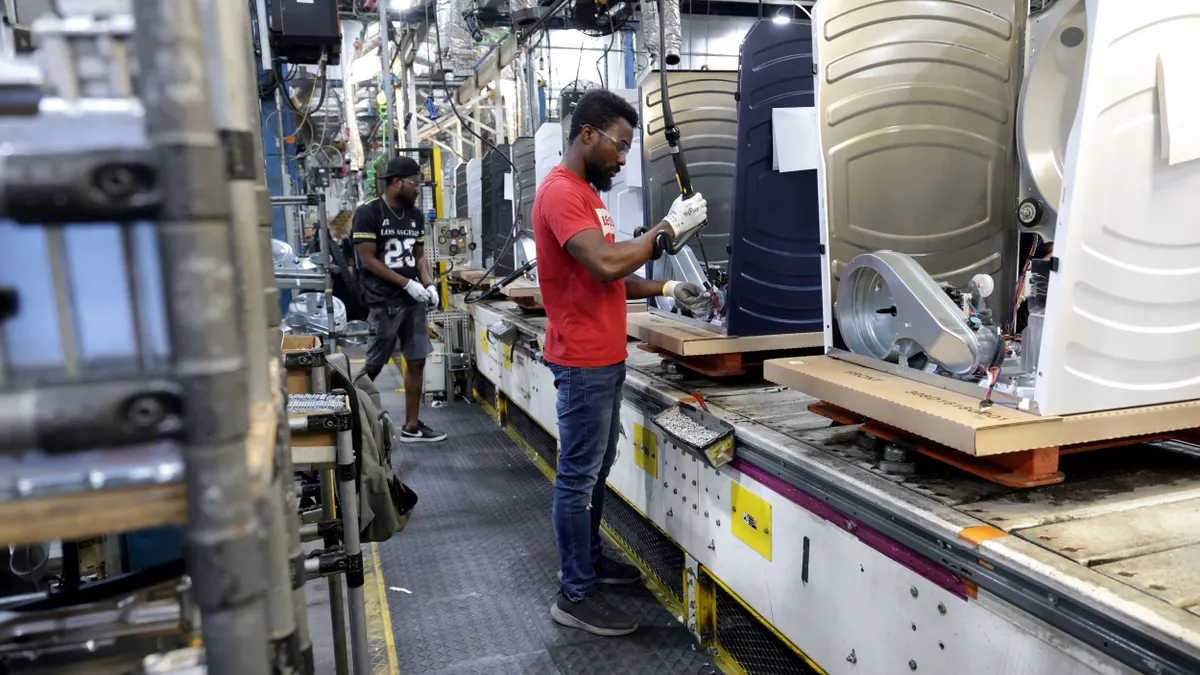When the federal government began its mass effort to return all employees to the office, it immediately garnered headlines for its chaos — not because of protest or pushback, but because of offices without Wi-Fi, lights or toilet paper.
That botched return highlighted a problem that may feel familiar to HR pros managing their own companies’ potential readjustments to office life: figuring out (or perhaps remembering) how to make office use effective, efficient and even a draw for workers.
“The office is built for humans,” Andrew Farah, CEO at Density, a tech firm focused on measuring office occupancy, told HR Dive. “We have very little idea how humans use offices.”
Employees, understandably, have nonnegotiables when it comes to work space, Janet Pogue McLaurin, global director of workplace research at Gensler, an architecture and design company, said. Sometimes, even those are not being met.
“A workplace that doesn’t work isn’t a work place,” she emphasized in an interview with HR Dive.
So what makes office space into a workplace?
Get the basics down.
When mandating a return to office, it may help to think small at first. How small?
Don’t forget badge access, for example, Farah said, so people can get into the office with ease. Make sure the office internet is ready for the bandwidth that will be required if more people will be sharing the same space, too.
“You have to conduct a workplace readiness audit,” Michelle Mikesell, chief people officer of G&A Partners, an HR services provider, told HR Dive. That includes providing workers with everything they might need, such as ensuring each workspace has docking stations, enough monitors, and adequate desk space.
Regular office attendees can be assigned a space. For everyone else, leaders must ensure there is hoteling or hotseat space, Mikesell said.
Farah also emphasized the importance of this. “Either make sure everyone has an assignment, or make sure your designated share space remains that way,” he said. Otherwise, people may feel like “‘I’m forced to be here, and there’s nowhere to sit,’” he added.
Many young workers and new graduates may be coming into an office environment for the very first time, Farah said, so they might not have an idea how to get their badge, computer or internet access. Have processes to enable all of these things, he added.
Space is at a premium. Use it wisely.
Actually useful physical space is also a basic requirement, but it is one that can trip employers up depending on how employees are encouraged to use that space.
“Beware the trap of having many [employees] come back but not enough,” Farah said. In other words, don’t be a remote company using the office for remote-only work; this leads to workers camping in rooms for meeting calls, he said. “Beware the conclusion that you have run out of space when you haven’t.”
The team at Gensler sought to understand the difference between offices that had been remodeled since the pandemic and those that had not undergone any changes, and they “saw some clear differences,” Pogue McLaurin said.

One of the largest issues they found was simple: The space sometimes doesn’t fit the work people are doing.
“People really want to come to the office to get their work done,” Pogue McLaurin said. “We’ve been asking for four years what the purpose of the office is,” and that is what employees tell them, she continued.
What spaces are people avoiding? What spaces are being used sideways to their actual intention? Employers can repurpose space accordingly, she explained.
Front-line managers and execs both need to be on board — and coming in.
As far as enabling a successful RTO, “the most important team is the exec team,” Farah said. They will likely be responsible for delegating RTO issues to the proper teams and also set the tone for everyone else.
Unfortunately, execs may act in ways that make it seem they won’t adhere to the rules they set. Many CFOs and other top executives, for example, make deals upon hiring that make it so they aren’t required to relocate, CFO Dive recently reported.
“You can’t say, ‘Do as I say, not as I do,’” Farah said. “You cannot do that and mandate a return.”
On the opposite end, front-line managers need to be empowered to help their direct reports while in the office, Mikesell said. When a worker needs help, “the first person someone is going to go to is their direct manager,” she noted. “Have manager training and support, and have those resources available.”
Her team also provides re-onboarding for those who have been remote for a long time, which includes teaching people how to access the tools they may need on-site and equipping managers to answer those questions, she added.
Policy matters.
Once a physical space is ready and leaders are fully briefed, HR can lead the charge on establishing office policy that includes aspects like expected core hours and commute considerations.
Density, for example, uses a “common hours” policy. Everyone is expected to be available in the office between 10 a.m. and 3 p.m. Initially, such a restriction may turn people off, “but practically, they really like it,” Farah said. Workers know they can schedule an in-person meeting with someone at a certain time, even if it constrains flexibility.
But even with such restrictions, a shared structure can help managers set clear boundaries — and let people be adults, he added. If someone needs to leave early for family reasons, for example, then teams can still work within the constraints to enable that.
Everything must be tied back to an organization’s goals for RTO, Mikesell reminded. “If you want to be more successful, you have to be purposeful about the time spent in the office,” she said. Are people expected to hold meetings and brainstorm together in the office? Then align those expectations with the policy and set clear guidelines, she added.
The policy can be simple and practical, Farah said — but don’t mandate RTO without one. Many companies are still “waiting to figure it out,” he continued. “Then it just turns into rumors.”
Make it worth their while.
Pogue McLaurin suggested that staff should be encouraged not to plan “excessive Zoom calls,” but instead create space for conversations to take place — because that is the main reason people want to be in the office in the first place, Gensler research found.
When the team asked what were the most important ways of working in an office, they were surprised by what they found, Pogue McLaurin said. “Scheduled team meetings came to the top,” she explained. But the next three were all forms of conversation — including impromptu chats between co-workers meeting face-to-face.
To better facilitate that, Gensler schedules all meetings to start with natural buffer time — for example, to start five minutes after the hour and end five minutes until the hour — to create those “moments that matter.”
Above all, make a return to office “worth their while,” Mikesell said.
“What are you doing that [requires] asking them to come back into the office?” she continued. “Be purposeful.”
And be aware that any shift in expectations around office presence may create strife.
“Companies don’t like to say this,” Farah explained, but conflict around RTO is likely inevitable. “Companies should say to their teams: For about 80% of things, the stuff that we are deciding to do is good for both [of us]. For about 20%, our interests diverge.”
That includes a mandated return to the office. What is good for a team might be at odds with the personal freedom that remote and distributed work once provided, he said.
“Our job is to do what is in the best interest of the team, not just the individuals,” Farah said. “You just want to be intellectually honest that this is one of those things.”
Correction: A previous version of this story mischaracterized how docking stations are used. The story has been updated to clarify.






















